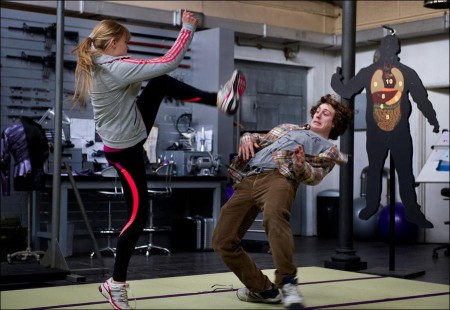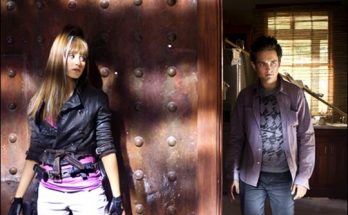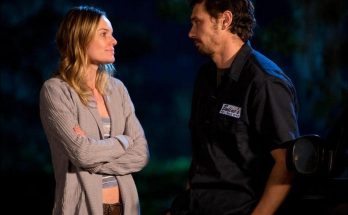Taglines: You can’t fight your destiny.
Kick-Ass, Hit-Girl and Red Mist return for the follow-up to 2010′s irreverent global hit: “Kick-Ass 2.” After Kick-Ass’ (Aaron Taylor-Johnson) insane bravery inspires a new wave of self-made masked crusaders, led by the badass Colonel Stars and Stripes (Jim Carrey), our hero joins them on patrol. When these amateur superheroes are hunted down by Red Mist (Christopher Mintz-Plasse)—reborn as The Mother Fucker—only the blade-wielding Hit-Girl (Chloe Grace Moretz) can prevent their annihilation.
When we last saw junior assassin Hit-Girl and young vigilante Kick-Ass, they were trying to live as normal teenagers Mindy and Dave. With graduation looming and uncertain what to do, Dave decides to start the world’s first superhero team with Mindy. Unfortunately, when Mindy is busted for sneaking out as Hit-Girl, she’s forced to retire—leaving her to navigate the terrifying world of high-school mean girls on her own. With no one left to turn to, Dave joins forces with Justice Forever, run by a born-again ex-mobster named Colonel Stars and Stripes.
Just as they start to make a real difference on the streets, the world’s first super villain, The Mother Fucker, assembles his own evil league and puts a plan in motion to make Kick-Ass and Hit-Girl pay for what they did to his dad. But there’s only one problem with his scheme: If you mess with one member of Justice Forever, you mess with them all.
Write It to Make It: Kick-Ass Is Reborn (2013)
“Kick-Ass,” the revolutionary creator-owned comic that Mark Millar launched with artist John S. Romita Jr. in 2008, challenged curious readers with one simple question: “Why has nobody ever tried to become a superhero?” The two men answered that query with a barrage of violence, memorable characters and quotable dialogue.
Freshly buoyed by the blockbuster success of the Universal actioner Wanted— based on his same-titled book—Millar began to explore the possibility of bringing “Kick-Ass” to the big screen. Because “Kick-Ass” was an independent comic, this allowed the creators greater freedom in approaching production partners who would appreciate the series’ bracingly unique storylines.
Around that time, director Matthew Vaughn was looking for his next project and had recently been introduced to Millar by Stardust co-writer Jane Goldman and her husband, Jonathan Ross. Millar later pitched Vaughn a number of ideas, but it was Kick-Ass that resonated most. Vaughn was determined to apply the same anarchic spirit of the comic to the filmic version—even if that meant including scenes in which an 11-year-old Hit Girl mows down dozens of heavily armed men with an arsenal of weaponry and a string of expletives. When turned down by Hollywood’s major studios, Vaughn decided to finance Kick-Ass independently.
Scripted by Goldman and Vaughn, Kick-Ass brought to the screen the wild story of Dave Lizewski, an ordinary Manhattan teenager who sets out to become a real-life superhero. Donning a green-and-yellow wet suit and calling himself Kick-Ass, he captures the imagination of the public and becomes an online phenomenon. Kick-Ass soon discovers he is not the city’s only superhero when he meets a fearless and highly trained father-daughter crime-fighting duo—the cowl-draped Big Daddy and ninja assassin Hit Girl. As Kick-Ass becomes entangled in their quest to take down the criminal empire of local ma ioso Frank D’Amico, our hero gains a nemesis of his own: Frank’s teenage son, Chris, who has taken to calling himself Red Mist.
The movie was nothing short of a huge gamble, but one that the filmmakers were prepared to take. Kick-Ass was lensed in 2008, with Vaughn showing it to potential distributors a year later. He subsequently sealed deals with Lionsgate and Universal Pictures to release it in the U.S. and internationally, respectively, in 2010. Kick-Ass was met with astonishing reviews such as Richard Corliss’ Time magazine rave: “It soars, jet-propelled, on its central idea of matching a superhero’s exploits with the grinding reality of urban teen life and on the aerodynamic smoothness of thefilm’s style.”
Although the groundbreaking film caused some critics to raise their eyebrows in dismay, it was adored by audiences who understood Vaughn’s strong desire to upend the genre. In turn, the movie pulled in almost $100 million globally, proved enormously successful on DVD/Blu-ray metrics and gained a passionate following along the way.
All the while, Millar and Romita continued the work on their homegrown saga. The first chapter of their follow-up comic series, “Kick-Ass 2, Issue 1,” debuted on October 20, 2010. Set several months after the events of the first run, the books reconnect us with Mindy and Dave as they struggle to keep their identities as Hit Girl and Kick-Ass a secret—while she trains him to be a better hero who can take a much-less forgiving punch. Meanwhile, Red Mist returns with an increasingly psychotic new attitude and an unprintable name change to match. Forming a group of super-villains, Chris takes the deadly game to the next level as he attempts to exterminate the duo that killed his reprobate father.
Twenty-four hours after its release, “Kick-Ass 2, Issue 1” sold out, and the “Hit Girl” companion title has since become the most popular comic book with a female lead in more than a decade. The irst two chapters of the “Kick-Ass 3” series are currently in release, completing the trilogy and bringing Dave Lizewski’s story to an exciting finish later this year.
Millar walks us through the evolution of this signature property: “Kick-Ass was about a guy deciding to become a superhero and influencing others to do the same. Kick-Ass 2 takes that idea and runs with it. Now we have this group of people who, inspired by the heroics of Kick-Ass, have formed a crime-fighting gang, Justice Forever. At the same time, Chris is embarking on the opposite journey. He has decided to become a self-proclaimed super-villain and is recruiting his own army. It takes something that was singular in the first movie and makes it into something more exciting. It’s that sense of escalation, of expansion, that you always want with a sequel.”
As Millar and Romita created the characters and own the rights to them, the two men take the fate of our everyday superheroes very seriously. Romita explains that he and Millar have just as much invested in the fate of Dave, Mindy and the other members of Justice Forever as the diehard fans do, and it is tough to create bad situations that happen to them. The artist says: “All of the interesting characters that are in Justice Forever, you want them to win. Here I am, a comic book artist, and I want these characters to be superheroes because I don’t want anything bad happening to them. I like all of them.”
Kick-Ass’ unexpected success, set the stage for a sequel; however, it would take a couple years for the next chapter to begin production. Kicking off in 2011, Vaughn met with Cry_Wolf director Jeff Wadlow to discuss a project known as Bloodshot. Wadlow had written the screenplay, and Vaughn was attached to direct.
Other commitments resulted in Vaughn’s inability to continue with Bloodshot, but he remained interested in working with this intriguing young director. When Vaughn’s obligations to the X-Men franchise wrapped him up for the foreseeable future, the filmmaker pondered abdicating both writing and directing duties to Wadlow, which would allow Vaughn to remain involved as a producer.
Wadlow was so adamant that Vaughn pass the mantle on to him, he set to work on a script without a deal yet in place. The filmmaker recalls: “I wrote it to direct it, and I wasn’t going to let anyone else do it. That’s the upside of taking on the risk of writing the script without a deal in place, initially. Even though Matthew and I talked a lot, I jumped before there was any real plan in place. I wanted to make the movie, and so I wrote it to make it.”
Vaughn offers that Wadlow was just the director to take the reins. He commends: “Je ’s pitch or Bloodshot was damn impressive, and then his script came in. It was exactly what his pitch was, which in Hollywood is very rare. I liked him, and he had a passion for comics, especially or ‘Kick-Ass.’” Still, the passing of the torch wasn’t immediate. Re lects Vaughn: “Even though I want to give people breaks, it was a weird decision to hand this over to a director. I thought I have to find the right person who is hungry, but has experience and is passionate. As well, I like writer/directors because it means they can know how to write a screenplay. Sometimes, you can have a great script then you hire a director who does something totally di erent with it.”
Kick-Ass 2
Directed by: Jeff Wadlow
Starring: Aaron Taylor-Johnson, Chloe Moretz, Morris Chestnut, Claudia Lee, Amy Anzel
Screenplay by: Jeff Wadlow, Mark Millar, John Romita Jr.
Production Design by: Russell De Rozario
Cinematography by: Tim Maurice-Jones
Film Editing by: Eddie Hamilton
Costume Design by: Sammy Sheldon
Set Decoration by: Sophie Newman
Music by: Henry Jackman, Matthew Margeson
MPAA Rating: R for strong violence, pervasive language, crude and sexual content, and brief nudity.
Studio: Universal Pictures
Release Date: August 16, 2013
Visits: 52






